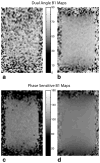Phase-sensitive sodium B1 mapping
- PMID: 21413078
- PMCID: PMC3073006
- DOI: 10.1002/mrm.22700
Phase-sensitive sodium B1 mapping
Abstract
Quantitative sodium MRI requires accurate knowledge of factors affecting the sodium signal. One important determinant of sodium signal level is the transmit B(1) field strength. However, the low signal-to-noise ratio typical of sodium MRI makes accurate B(1) mapping in reasonable scan times challenging. A new phase-sensitive B(1) mapping technique has recently been shown to work better than the widely used dual-angle method in low-signal-to-noise ratio situations and over a broader range of flip angles. In this work, the phase-sensitive B(1) mapping technique is applied to sodium, and its performance compared to the dual-angle method through both simulation and phantom studies. The phase-sensitive method is shown to yield higher quality B(1) maps at low signal-to-noise ratio and greater consistency of measurement than the dual-angle method. An in vivo sodium B(1) map of the human breast is also shown, demonstrating the phase-sensitive method's feasibility for human studies.
Copyright © 2010 Wiley-Liss, Inc.
Figures





References
-
- Borthakur A, Shapiro EM, Beers J, Kudchodkar S, Kneeland JB, Reddy R. Sensitivity of MRI to proteoglycan depletion in cartilage: comparison of sodium and proton MRI. Osteoarthritis Cartilage. 2000;8:288–293. - PubMed
-
- Reddy R, Insko EK, Noyszewski EA, Dandora R, Kneeland JB, Leigh JS. Sodium MRI of human articular cartilage in vivo. Magn Reson Med. 1998;39:697–701. - PubMed
-
- Wheaton AJ, Borthakur A, Shapiro EM, Regatte RR, Akella SV, Kneeland JB, Reddy R. Proteoglycan loss in human knee cartilage: quantitation with sodium MR imaging—feasibility study. Radiology. 2004;231:900–905. - PubMed
-
- Ouwerkerk R, Bleich KB, Gillen JS, Pomper MG, Bottomley PA. Tissue sodium concentration in human brain tumors as measured with 23Na MR imaging. Radiology. 2003;227:529–537. - PubMed
Publication types
MeSH terms
Substances
Grants and funding
LinkOut - more resources
Full Text Sources
Other Literature Sources
Medical

